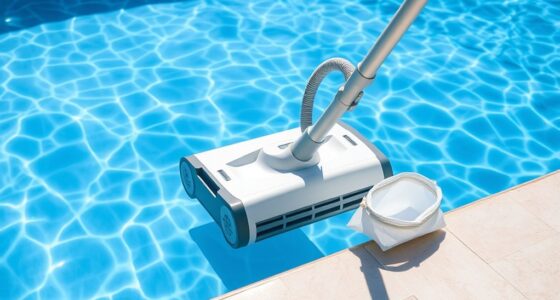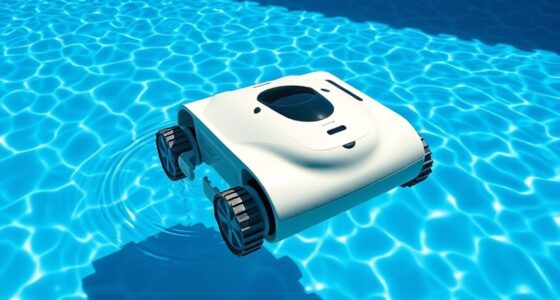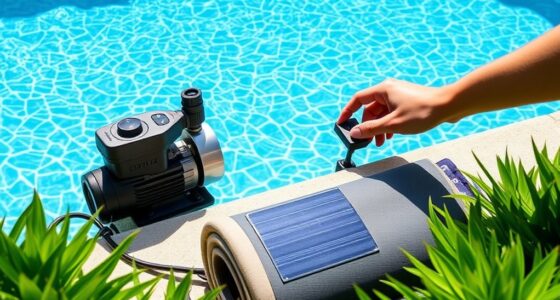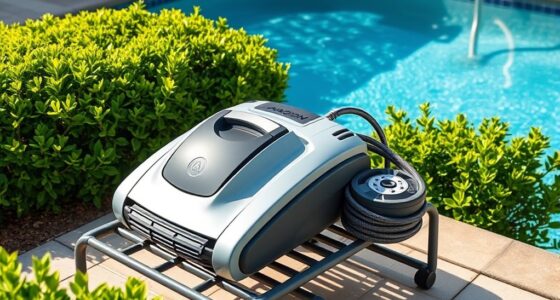To avoid your pool water from turning green, adhere to these top tips: Maintain proper pH levels to prevent algae growth. Regularly clean or replace pool filters for effective filtration. Use algaecides periodically to deter algae growth. Apply shock treatments as needed to keep chlorine levels stable. Monitor water quality regularly to identify and correct any imbalances promptly. Vacuum, skim, and scrub your pool on a regular basis to keep it clean. Following these guidelines will help keep your water sparkling clear and free of algae.
Key Takeaways
- Maintain proper pH and alkalinity levels to inhibit algae growth.
- Regularly monitor and adjust chlorine levels for water sanitization.
- Use preventive algaecide treatments every 1-2 weeks.
- Consider shock treatment after heavy pool usage or algae growth.
- Implement routine maintenance practices for a pristine pool.
Proper Ph Level Maintenance
Maintaining the proper pH level in your pool is essential for preventing algae growth and ensuring a safe swimming environment. A pH level between 7.2 and 7.6 is key to keep algae at bay.
When the pH level rises above 7.8, you might notice your pool water turning green due to algae proliferation. On the other hand, a pH level below 7 can lead to skin and eye irritation for swimmers and may also contribute to algae growth.
To prevent your pool water from turning green, it's important to regularly test and adjust the pH levels. Proper pH balance not only keeps the water clear and blue but also ensures that the chlorine in your pool remains effective in combating algae and bacteria.
By maintaining the pH within the recommended range, you can enjoy a sparkling pool that's safe for swimming, free from the threat of algae-induced green water.
Regular Pool Filter Cleaning

Regular pool filter cleaning is essential to maintaining a healthy swimming environment.
You should adhere to a consistent maintenance schedule tailored to your specific filter type.
Neglecting this task can result in poor water quality and potential issues like algae growth.
Filter Maintenance Frequency
To guarantee maximum filtration efficiency, it's essential to clean cartridge filters every 2-6 weeks.
Regular maintenance of diatomaceous earth filters involves back-washing every 1-3 months to maintain proper function.
Sand filters, on the other hand, typically require back-washing every 1-4 weeks to prevent debris buildup and maintain water clarity.
- Cleaning cartridge filters every 2-6 weeks is vital for the best filtration efficiency.
- Back-washing diatomaceous earth filters every 1-3 months helps sustain proper function.
- Back-washing sand filters every 1-4 weeks prevents debris buildup and ensures clear pool water.
Proper Cleaning Techniques
For optimal pool water quality, stick to a consistent filter cleaning schedule to prevent debris accumulation and maintain efficient filtration. Regularly cleaning your pool filters is vital in preventing algae buildup and making sure that your pool water remains clear and blue.
Depending on the type of filter you have, the maintenance frequency varies. Cartridge filters should be cleaned every 2-6 weeks, diatomaceous earth filters should be back-washed every 1-3 months, and sand filters should be back-washed every 1-4 weeks.
Dirty filters can lead to dirty pool water, so it's important to follow the manufacturer's recommendations for proper filter maintenance. By keeping up with the filter cleaning schedule based on your filter type, you can ensure efficient water circulation and filtration, reducing the risk of green pool water.
Importance of Consistency
Consistently cleaning your pool filters is essential for maintaining ideal water circulation and preventing algae growth. When you neglect filter cleaning, algae can quickly take hold in your pool, turning the water green and making it uninviting for swimming.
To avoid this issue, here are three important reasons why regular pool filter cleaning is paramount:
- Efficient Debris Removal: Regular cleaning ensures that your filters can effectively trap debris and contaminants, preventing them from clouding your pool water and promoting algae growth.
- Optimal Filtration: Unclean filters lead to poor filtration, allowing algae spores to flourish and causing your pool water to turn green. By cleaning your filters consistently, you maintain proper filtration and keep algae at bay.
- System Effectiveness: Following a recommended cleaning schedule keeps your filtration system working efficiently, reducing the chances of your pool water turning green due to algae infestations.
Routine Maintenance Tasks

To guarantee your pool stays clean and safe for swimming, it's essential to regularly test and adjust the pH and alkalinity levels of the water.
Keeping a proper filtration system in good working order is vital for maintaining clear water and preventing debris buildup.
Implementing effective algae prevention methods, such as algaecide treatments and routine cleaning, will help you enjoy a sparkling pool all season long.
Water Testing Frequency
Consistently monitoring your pool water's pH and chlorine levels is essential for maintaining a healthy balance and preventing issues like green water. Testing pool water pH and chlorine levels at least twice a week is important to guarantee that the chemical levels are within the recommended range.
Regular water testing not only helps in identifying any imbalances early on but also plays a significant role in preventing the dreaded green water in your pool.
In addition to pH and chlorine levels, it's also crucial to monitor alkalinity and calcium hardness levels to maintain overall water quality.
- Test pool water pH and chlorine levels at least twice a week to maintain balance.
- Regular water testing helps identify issues early and prevent green water.
- Monitoring alkalinity and calcium hardness levels is important for water quality.
Proper Filtration System
Regularly cleaning or replacing your pool filters is vital for ensuring efficient filtration and preventing algae buildup. Proper filter maintenance is essential in removing debris, contaminants, and algae from the pool water, contributing to overall water clarity and health.
Backwashing sand filters every 1-4 weeks, cleaning cartridge filters every 2-6 weeks, and backwashing diatomaceous earth filters every 1-3 months are recommended schedules to follow. By adhering to these maintenance tasks, you help maintain a clean and healthy pool environment by aiding in the removal of impurities that can lead to green water.
Consistent filter cleaning not only enhances the effectiveness of water circulation but also ensures that your pool water remains crystal clear. Remember, efficient filtration is key to preventing algae growth, so stay diligent in your filter maintenance routine to enjoy a sparkling pool all season long.
Algae Prevention Methods
How can you effectively prevent algae growth in your pool through routine maintenance tasks?
Maintaining proper pH levels and alkalinity, along with consistent pool maintenance, is key.
Here are some strategies to help you prevent algae in your pool:
- Regularly test and balance pH levels: Guarantee that your pool water has the correct pH and alkalinity levels to create an environment where algae struggle to thrive.
- Utilize algaecides and shock treatments: When needed, use these products to combat algae buildup effectively and prevent it from spreading.
- Keep pool filters clean: Regularly clean and maintain your pool filters to ensure they're working at their best and preventing algae from flourishing.
Balanced Chemical Levels

Maintaining balanced chemical levels in your pool is essential for ensuring water quality and preventing issues such as algae growth and contamination. Proper pH levels, typically ranging between 7.2 and 7.6, are vital as they help prevent algae from thriving in your pool.
Additionally, keeping alkalinity levels between 80-120 ppm contributes to balanced water chemistry, further inhibiting algae growth. Regularly monitoring chlorine levels is equally important to make sure that they're at the appropriate levels for effectively sanitizing the pool water.
Chemical imbalance can lead to algae proliferation, which is why using algaecides regularly is recommended to combat algae buildup and prevent the water from turning green. Remember to test and adjust chemical levels consistently to maintain crystal clear water and a healthy swimming environment.
Effective Filtration Techniques

For ideal pool water quality, ensuring efficient filtration techniques is essential to prevent debris and algae buildup. Proper maintenance of your pool filter plays a critical role in keeping your water clean and clear.
Here are some key practices to enhance your filtration system:
- Regularly backwash your sand filter every 1-4 weeks to maintain peak filtration efficiency.
- Clean your cartridge filters every 2-6 weeks to prevent algae growth and guarantee proper water circulation.
- Diatomaceous earth filters should be backwashed every 1-3 months for the best filtration results.
Preventive Algaecide Use

When it comes to maintaining your pool water, preventive algaecide use is essential. By applying algaecides regularly, you can inhibit algae growth and keep your water clear.
Understanding the frequency of application, selecting the right algaecides, and calculating proper dosages are key aspects to effective algae prevention.
Algaecide Application Frequency
Consider incorporating a routine preventive algaecide schedule every 1-2 weeks to effectively inhibit algae growth in your pool. Regular algaecide use plays a vital role in maintaining a clear pool, as algaecides work by disrupting algae cell membranes, preventing their growth.
By following a consistent preventive algaecide application frequency, you can greatly reduce the need for shock treatments to clear algae outbreaks. To guarantee best results, always adhere to the proper algaecide dosage recommended by the manufacturer.
- Consistent preventive algaecide application every 1-2 weeks disrupts algae growth.
- Proper dosage of algaecide is essential for effective algae prevention.
- Regular algaecide use can minimize the need for shock treatments to clear algae.
Choosing Effective Algaecides
To effectively maintain clear pool water and inhibit algae growth, it's important to select algaecides that target specific algae strains for best efficiency. Algaecides are specially formulated chemicals designed to prevent algae growth in pools. By incorporating preventive algaecides into your pool maintenance routine, you can disrupt the algae's ability to photosynthesize, ultimately preventing their growth and keeping your pool water crystal clear.
Different types of algaecides are available, each targeting specific algae strains for top effectiveness. Regularly using these algaecides can help prevent green water and unsightly algae blooms, ensuring your pool remains inviting and enjoyable for swimmers.
When choosing an algaecide, consider factors such as the specific algae strains present in your pool and the product's effectiveness against them. By making an informed decision and including algaecides in your pool maintenance plan, you can effectively combat algae growth and maintain a pristine pool environment.
Algaecide Dosage Calculation
Calculate the appropriate algaecide dosage for your pool based on the pool size, aiming to use 1.5 ounces per 10,000 gallons of water as a general guideline.
For preventive use, make sure you follow these best practices:
- Double the algaecide dosage for severe algae growth or persistent green water issues.
- Distribute algaecide evenly around the pool perimeter with the pump running to guarantee proper dispersal.
- Avoid adding algaecide in one concentrated area to prevent staining or damage to pool surfaces.
Shock Treatment Implementation

When should you consider implementing shock treatment in your pool water maintenance routine?
Shock treatment should be considered after heavy pool usage, periods of rain, or when algae growth is visible in your pool. This process involves adding a high dose of chlorine to kill algae, bacteria, and other contaminants in the water. By shocking your pool, you can restore chlorine levels, eliminate chloramines, and prevent further algae growth.
The amount of shock needed will depend on factors such as the size of your pool, the current condition of the water, and the type of shock product being used.
After shock treatment, it's important to run your filtration system for at least 24 hours to remove dead algae and contaminants from the pool water.
Implementing shock treatment as needed can help maintain water clarity and ensure a healthy swimming environment for you and your guests.
Consistent Water Quality Monitoring

After implementing shock treatment in your pool water maintenance routine, the next step is to regularly monitor the water quality to guarantee a healthy swimming environment. Consistent water quality monitoring is essential to prevent issues like green tint in the water due to algae growth, ensuring that your pool remains inviting and safe for use.
To effectively monitor your water quality, consider the following:
- Regular testing: Test your pool water frequently for pH, chlorine, and alkalinity levels to maintain the proper balance essential for healthy water quality.
- Preventing algae growth: Monitoring the water quality helps in early detection of any imbalance that could lead to algae growth, keeping your pool water clear and algae-free.
- Timely adjustments: Consistent testing allows you to make prompt adjustments to chemicals and maintenance routines, preventing potential problems before they escalate.
Maintaining a routine schedule for water quality checks is key to enjoying a crystal-clear pool without the worry of algae taking over.
Regular Cleaning Practices

Wondering how to maintain a sparkling clean pool? Regular cleaning practices are key to preventing algae growth and keeping your pool water crystal clear. Start by regularly vacuuming and skimming the pool to remove debris that can contribute to algae formation. Additionally, make sure to scrub the pool walls and floor frequently to prevent algae from sticking and thriving.
Cleaning the pool filters on a consistent basis is essential for proper filtration and circulation of water. This helps in removing impurities and maintaining water clarity.
In addition to cleaning, testing and balancing the pool water chemistry regularly is important. By monitoring and adjusting the chemical levels, you can prevent algae blooms and maintain a healthy swimming environment.
Implementing a routine maintenance schedule for cleaning tasks is crucial in preventing green water and maintaining a pristine pool. By staying on top of these cleaning practices, you can enjoy a clean and inviting pool all season long.
Maintenance for Crystal Clear Water

To maintain crystal clear water in your pool, prioritize regular testing and balancing of pool water chemistry. This important step ensures that the proper pH levels are maintained, preventing algae growth and keeping your water pristine.
Alongside this, shocking your pool periodically helps to eliminate any organic contaminants that may have built up. Additionally, incorporating regular maintenance practices such as cleaning and maintaining pool filters on a set schedule is essential for efficient filtration, which further aids in algae prevention.
Vacuuming and brushing the pool walls and floors also play a significant role in preventing algae buildup and maintaining water clarity. Proper circulation through clean skimmer systems helps remove debris effectively, contributing to the overall cleanliness of the water.
Frequently Asked Questions
How to Keep Swimming Pool Water From Turning Green?
To keep swimming pool water from turning green, it's important to maintain proper pH and chlorine levels. Ensure good water circulation by cleaning filters and running the pump adequately. Use algaecides and shock treatments as needed. Vacuum and brush the pool regularly to prevent algae growth. Consider seeking professional pool maintenance services for expert care.
Preventing algae growth through consistent maintenance is key to maintaining clear pool water and preventing it from turning green.
How Do I Keep My Pool From Turning Green Without a Filter?
To keep your pool from turning green without a filter, there are several key steps you can take.
Maintain proper chlorine levels by regularly shocking the water. Use algaecides to prevent algae growth and promote clear water.
Implement good water circulation practices like manual brushing and vacuuming to prevent algae buildup. Monitor and balance pH levels to deter algae growth.
Cover the pool when not in use to prevent debris accumulation and reduce the risk of algae formation.
Why Do Pools Turn Green so Fast?
Pools turn green swiftly primarily due to algae growth, spurred by factors like warm weather and imbalanced chlorine levels. Neglecting regular maintenance, like filter cleaning, can also speed up this process.
Additionally, pollutants such as pollen contribute to algae buildup, turning your pool into a green mess in no time. It's essential to stay on top of water quality and maintenance to prevent this rapid color change.
How Do You Clear a Green Pool in 5 Days or Less?
To clear a green pool in 5 days or less, you need to shock it with a high dose of chlorine to kill algae rapidly. Brush and vacuum daily to remove algae, use algaecide for prevention, and run the filtration system continuously for proper circulation.
Test and balance water chemistry to avoid future algae outbreaks. Following these steps diligently will help you restore your pool to a clear and clean state within the specified time frame.
What Eco-Friendly Practices Can Help Prevent Pool Water From Turning Green?
To prevent pool water from turning green, consider using ecofriendly swimming pool water reuse techniques. Implement a rainwater collection system to top off pool water, reducing the need for tap water. Utilize natural plant-based pool cleaners rather than harsh chemicals. Also, regularly clean pool filters to maintain water quality.
Conclusion
To sum up, by following these best practices for pool water maintenance, you can prevent your pool water from turning green and guarantee crystal clear water for your enjoyment.
Remember, a stitch in time saves nine – taking proactive steps now will save you from dealing with more significant issues later on.
So, stay diligent with your pool maintenance routine and enjoy a clean and inviting swimming experience all season long.










